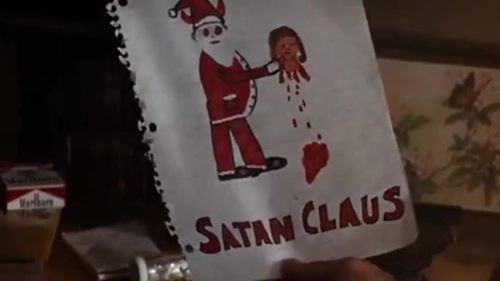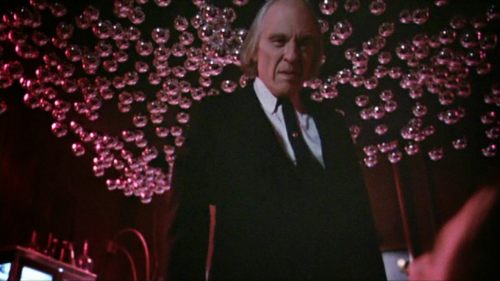The Ball Is Back: PHANTASM II
“You think that when you die, you go to Heaven. You come to us.”
Phantasm II is a strange, double-edged sword. Certainly one of the better horror sequels ever made, once you consider the circumstances that led to its development (franchise-hungry Universal greenlit a follow-up almost a decade after the initial film dropped), the fact that the film’s watchable at all is a minor miracle unto itself. Don Coscarelli’s stated numerous times that he always envisioned Phantasm as a one-and-done, and that leads to the problematic elements that plague its successor’s apocalyptic narrative. By continuing the adventures of Mike (James Le Gros, replacing Michael Baldwin – we’ll get there in a sec) and Reggie the Ice Cream Man (Reggie Bannister), the sequel ends up undoing the bereavement reverie nature of the original, thus automatically robbing the ’88 gore freak-out of preloaded pathos right out of the gate. Yet what Phantasm II lacks in poignancy, it more than makes up for in rubbery weirdness and goofy spectacle, as Coscarelli stretches every dollar of his $3 million budget to indulge these otherworldly fantasies.
Like a kid in a candy store, Coscarelli opens Phantasm II with not one, but dual explosions that detonate entire suburban homes in flashes of destruction. The first is Mike and Jody’s inherited domicile from the original, as we pick up literally where Phantasm left off. Mike is attacked by the creepy Tall Man (Angus Scrimm) in his room after Reggie tells him to go pack a bag for their getaway to Anywhere But Here. While fiddling with his acoustic axe in the living room, Reg hears the commotion upstairs and races to try and save his friend, but is cornered by the Tall Man’s dwarves in the kitchen. Knowing he won’t be able to shoot his way out, our bald, ponytailed champion cranks the gas on the stove and grabs his surrogate little bro, ducking outside just as the whole house goes up like Mexican fireworks. As John Ford once taught us when answering the question as to why nobody ever shot the horses in his Westerns, we know the blast didn’t kill the Tall Man, and fast forward almost ten years into the future.
The subsequent blast comes after Mike fakes his rehabilitation in the loony bin, where’s he spent the better part of a decade trying to convince doctors that he’s not making any of this wild shit up. Why Reggie couldn’t keep the kid out of the hospital remains a mystery, but that doesn’t stop him from dropping in on Mike’s post-release grave exhumation at Morningside Cemetery. Mike knows that the Tall Man is still out there, as a psychic connection he’s established with the similarly haunted Liz (Paula Irvine) tells him so. Reggie’s not buying it, but on their way back to the Ice Cream Man’s home, another vision hits Mike seconds before Reggie’s house goes ka-boom! Now the two are united again in their quest to hunt down this interdimensional Lord of the Damned, as they roar down the road in that oh-so-cool Hemicuda, breaking into firearms stores along the way and welding quad-barreled shotguns for themselves to take aim with.
If you read all of that and thought “this doesn’t seem to make a lick of sense”, you’re not entirely wrong (or wrong at all, really). Phantasm II retains the almost-Italian anti-narrative nightmare logic that drove the first (which was, in one way or another, an anxiety dream Mike endures following the passing of his brother, Jody [Bill Thornbury]). Coscarelli’s sequel isn’t so much plot-driven as it is a labyrinth of twisted Americana. Mike and Reggie cut their way across two-lane blacktop into the diseased heart of a United States that’s already witnessed an apocalypse of sorts. The Tall Man has decimated towns, nestling into the Pacific Northwest and amassing an army of mutated undead. Liz’s grandmother and grandfather are next – prized possessions the stiff mortician cannot wait to get his claws on. Like a protagonist from a lost Dario Argento picture, she calls out to Mike with her mind, drawing him nearer and nearer to possibly his own demise. Sure, the tale is linear in a very literal fashion as the Hemicuda follows this road to nowhere, but Coscarelli begs us to abandon any semblance of logic or reason beyond a very black and white battle between good and evil. The living, the dead, and a great ocean of bodies the Tall Man can pick from prepare for a war we’re not ready for.
Coscarelli crafts this sprawling non-reality with an eye for golden hour texture, as the sun always seems to be setting – giving way to dusk and encircling darkness. Cinematographer Daryn Okada would go on to have quite the career lensing Hollywood comedies, but in ’88 he shot both this and Survival Quest for the relentlessly odd auteur. Okada immerses us in the landscapes that flank these zigzagging highways, before taking the audience by the hand and leading them down the stone hallways of a new mortuary the Tall Man has taken up in. Inside, deep reds, browns and blacks saturate the interiors, as religious symbolism is barely necessary in this modern Hell. There’s a familiarity to the production design, as Phillip Duffin replicates many spaces from the original, but beefs up the aesthetics with the same attention to gothic detail he showcased in Renny Harlin’s Prison the previous year. Phantasm II is a lush, lovely movie, true to the VHS splatter era but with the backing of a major studio, lending the entire production an air of legitimacy many of its peers did not own. These are obviously apparitions that were dancing around in Coscarelli’s head for a half decade of radio silence following The Beastmaster’s minor success in ’82.
The major point of contention for many of the franchise’s fans is James Le Gros (Solarbabies) replacing Michael Baldwin, and that criticism is completely warranted, if somewhat beyond Coscarelli’s control (Universal forced the filmmaker to recast the role with a “working” actor, which Baldwin was not). Le Gros asserts himself admirably, acting as a beefy yin to Reggie’s unlikely hero yang. There’s undoubtedly an oafish doofiness to Le Gros that Baldwin didn’t possess, and it somewhat fits the character’s storyline within Phantasm II. This Michael would probably have to display a more outward toughness after having developed inside of the system; the soft-spoken little boy from the original now a distant memory thanks to growing up sans a big brother in a hardened prison of mentally imbalanced inmates. So, while the innocence so many connected with in the first film is gone completely, Le Gros’ beefier take feels thematically justifiable. Add on the fact that he’s not handsome in a traditional Hollywood sense (making him a much better fit than Brad Pitt, who auditioned for the role), and we’ve got an extension that’s easy to rationalize, even if the creative interference is impossible to defend.
Though it may have dropped the angst of the original’s POV, that doesn’t make Phantasm II any less of a teen boy’s fantasy. Every creature is brought to tangible, goopy life by KNB EFX, as monsters grow out of girls’ backs and the flying spheres of doom (which are now equipped with lasers and buzz saws) drill holes in priests’ skulls. Mike and Reggie also get to love up on the women they encounter, as Liz confesses adoration to her psychic other half in a non-verbal exchange that’s as silly as this sentence reads. Reggie gets in on the action too, as a beautiful hitchhiker (Samantha Phillips) tears off her shirt, mounts him, and starts slapping Reg’s bald head in a fit of ecstasy. To top it all off, hydrochloric acid melts corpses from the inside out, and the climax contains a chainsaw duel that’s a fist pumping highlight. Coscarelli is most certainly having a ball (sorry, not sorry) while expanding these characters’ world, transforming the planet into a creature feature funhouse that’s sure to delight horror diehards.
It’s easy to blame Universal for the film’s failures – both at a creative level (Le Gros), and at the box office (why this movie was released in July makes sense to literally no one). But without the backing of the studio, we’d arguably never have what is easily one of the weirdest movies to come through that system. By helping to empower filmmakers like Coscarelli, Wes Craven (The People Under the Stairs), and Sam Raimi (whose Evil Dead trilogy they’d cap with Army of Darkness in ’92), Universal was bringing seriously strange horror to thousands of screens across America. The Phantasm series would return to its independent roots for the third, fourth and fifth installments, yet for a bright shining moment during the Summer of ’88, surrealist scares were beamed directly into the eyeballs of mall crowds everywhere. The nightmare continued, but we’d have to wait six more years before hearing from the Lord of the Dead again.



